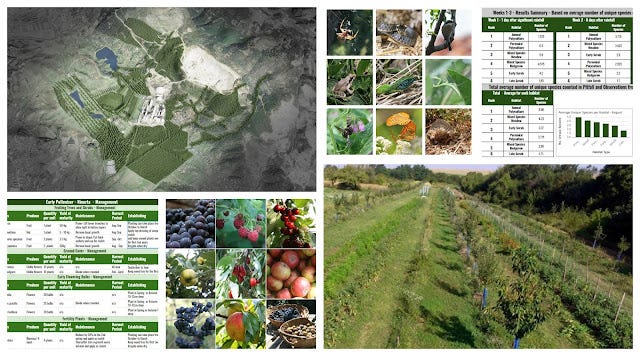 |
| Fruit in December. Following a few weeks of sub zero night time temperatures the fruits become soft. |
So here's some more details on these fascinating plants including how to grow them, different cultivars, using them in polycultures (for which they're great!) and more.
But first, just to let you know about our Online Store where you can find Forest Garden/ Permaculture plants, seeds, bulbs and Polyculture multi-packs along with digital goods and services such as Online Courses, Webinars, eBooks, and Online Consultancy. We hope you enjoy the store and find something you like :) It's your purchases that keep our Project going. Yuu can also find our full list of trees. shrubs and herbs for forest gardens on our website here
 |
| Plants, Seeds, eBooks, Consultancy, Bulk Fruit and Nut Tree Orders for Permaculture, Polyculture, Forest Gardens and Regenerative Landscapes. |
Chaenomeles speciosa - Japanese Quince
Genus - Chaenomeles
Species - C. speciosa
Other Common Names - Flowering Quince, Chinese Quince, Zhou Pi Mugua
Synonyms -C. laganaria. Cydonia lagenaria. Cydonia speciosa. Pyrus japonica. non Thunb.
 |
| The first flowers and fruits arrived in fourth year (grown from seed) |
Overview
Hardiness - This species is hardy to about -25°c USDA zone 5
Biodiversity - The flowers are attractive to a wide range of pollen and nectar feeding invertebrates from March- April, sometimes in February. The shrubs form compact and virtually impenetrable hedges. They are perfect territory for sheltering bird nests and the homes of other small wildlife.
Pollination - The flowers are hermaphrodite (have both male and female organs) and are pollinated by bees.
Propagation - Seed - These plants are easy to grow from seed. The seed can be sown inside late January - early February and should germinate within 30 days. We sow in trays with a 50% sieved compost 50% river sand mix. The seedlings should be pricked out and moved into deep pots or a seedling bed when large enough to handle. The largest plants can be planted out in their permanent positions in the summer. Smaller plants should spend their first winter under cover and can be planted out the following spring. When given water during dry periods and a little protection from encroaching weeds the plants establish very quickly (we have seed available for delivery see here).
Propagation - Basal Cuttings - You can cut away pieces of stems from the base that have some root tissue and plant these in deep pots. The following year the pieces will have developed a reasonable root system and can be planted out in their permanent position. Layering also works well for this plant.
Want to learn more about Regenerative Landscape Design? Join The Bloom Room!
The Bloom Room is designed to create a space for more in-depth learning, for sharing projects and ideas, for seeking advice and discovering opportunities.
Ultimately, it aims to build a more intimate, interactive, and actionable relationship between members, a way for the Bloom Room community to support each other’s projects and learning journeys, and to encourage and facilitate the design, build, and management of more regenerative landscapes across our planet.
What you can expect as a member of the Bloom Room
As a member of the Bloom Room you can expect;
Access to an interactive forum where you can ask questions, direct what type of content you would like to see as well as share your own content and projects.
Monthly live session featuring general Q&A and tutorials on design software for creating and presenting polycultures.
Live session every month for members to showcase your projects, plans, designs, and gardens, with guest speakers from the community.
Full Access to all of the content on Substack
A 50% discounts on all of our online courses
Future opportunities to join our Global Regenerative Landscape Design and Consultancy Service, with potential roles for those with the will and skill to join our design team.
An opportunity to take part in the group ownership of a Regenerative Landscape. You will find more details on that here.
Become a paid subscriber to our Substack to join. The annual subscription is currently $70 and the monthly subscription is $7 (monthly subscription excludes discounts for products and services) . You can join here, we look forward to meeting you!
Where to Plant
Soil - The plant is easily cultivated in any reasonably good soil and can grow well in heavy clay soils. Like most plants, they prefer a deep moist well-drained loam. In our experience they can tolerate waterlogged soils but probably not for entire seasons. Avoid high pH soil (alkaline) which will result in chlorosis.
Fertility, Irrigation and Care
Irrigation - They are considerably drought tolerant, but if you would like high yields then irrigation during periods of drought is recommended.
Weeding - It's important to keep the plants free from weeds while they establish as young trees. Mulching the plants for the first few years while they establish is recommended.
Trimming - Trimming the shrubs can keep them compact and encourage dense multi- stemmed growth. The trimmings can be used for mulch and for rabbit food.
Potential Problems
Insect/Pest: Scale, mites and aphids can be problematic, but we have not experienced this personally.
Disease: Apple scab can cause significant defoliation by mid-summer. Susceptible to fungal leaf spot (particularly in years with heavy spring rainfall) which can cause considerable leaf defoliation. Fire blight and scab can be problems in some areas.
Chalky Soils - Chlorosis (yellowing of foliage) will occur in high pH soils.
Frosts - Flower buds are susceptible to significant damage from early spring frosts.
Japanese Quince Uses
Fruits - Fruit eaten raw or cooked. Fruit exposed to cold temperature softens and can be used in the place of lemons. Fruits contain high levels of pectin and are used for jam making. In Japan they mix quinces, sugar, and alcohol to make a liquor. While researching the plant for this post I also came across what looks likes a fabulous recipe. Place the quince in jars and fill with honey, boil the jars and you have quince infused honey/syrup.
Hedging - The plants take well to trimming and can be used to form a hedge. Annual trimming does not drastically reduce flowering or fruit formation.
Bee Plant - Flowering in early March, it provides a early source of nectar/pollen to bees. The flowering period can last up to 3 weeks.
Medicinal uses - Japanese quince has three primary medicinal uses. The first is as an anti-inflammatory in joint and muscle problems; the second is to treat and cure seasonal respiratory illness; the third is as a general tonic to stimulate health or recovery from illness. For more on the health benefits take a look here .
Other uses - It's actually not a bad producer of biomass and can be trimmed up to 3 times a year once established. The thorns make it uncomfortable to handle but it's okay for mulching perennial beds. It would be interesting to experiment with how hard the plant can be pruned and how fast it comes back.
Regenerative Landscape Design - Online Interactive Course
Want to learn how to design, build and manage regenerative landscapes? Join us on our Regenerative Landscape Design - Online Interactive Course. We look forward to providing you with the confidence, inspiration, and opportunity to design, build and manage regenerative landscapes, gardens, and farms that produce food and other resources for humans while enhancing biodiversity.
You can find the course details here and at the moment we have a $350 ( 20%) discount for full enrollment to the course. Just use RLD2024 in the promo code section of the registration form to receive your discount.
Japanese Quince Yields
 |
| Variable sizes of Chaenomeles spp. Photo from - http://doctorschar.com/japanese-quince/ |
Growing Japanese Quince in Polycultures
This plant features in many of our polycultures including our early pollenizer guild (coming soon), living fences, and support islands around the vegetables where we grow the plant with Ribes nigrum, Allium schoenoprasum, Rudbeckia laciniata and Primula vulgaris ground cover.
 |
| It's not a great photo but you can see the Rudbeckia sp. on the left, Allium sp, in the foreground with Ribes sp. and Chaenomeles sp. in the background with Primula vulgaris ground cover. |
 |
| Illustration of polyculture. Plants are more or less to scale |
All of these plants are available from our Bionursery and can be delivered to anywhere in Europe.
Cultivars/Varieties
Support Our Project
If you appreciate the work we are doing you can show your support in several ways.
Become a member of the Bloom Room. A $70 annual or $7 per month subscription to our Substack provides you with access to live sessions, design tutorials, a members forum and more, see details here.
Make a purchase of plants or seeds from our Nursery or Online Store
Joining us for one of our Practical Courses or Online Courses
Comment, like, and share our content on social media.
If you appreciate the work we are doing you can show your support in several ways.
Become a member of the Bloom Room. A $70 annual or $7 per month subscription to our Substack provides you with access to live sessions, design tutorials, a members forum and more, see details here.
Make a purchase of plants or seeds from our Nursery or Online Store
Joining us for one of our Practical Courses or Online Courses
Comment, like, and share our content on social media.
References
- http://hort.uconn.edu/detail.php?pid=104
- http://doctorschar.com/japanese-quince/
- http://www.pfaf.org/USER/Plant.aspx?LatinName=Chaenomeles+speciosa
- http://www.missouribotanicalgarden.org/PlantFinder/PlantFinderDetails.aspx?kempercode=c298
- http://www.lvai.lv/ENG/Research.html








Another excellent informative article, thank you!
ReplyDeleteThis was perfectly written. Thank you!
ReplyDeletePlease any one help me and tell me about those plants which have no antimicrobial activity and available in pakistan plesae please
DeletePlease any one help me and tell me about those plants which have no antimicrobial activity and available in pakistan plesae please
ReplyDeletesorry, I don't understand the question?
ReplyDelete